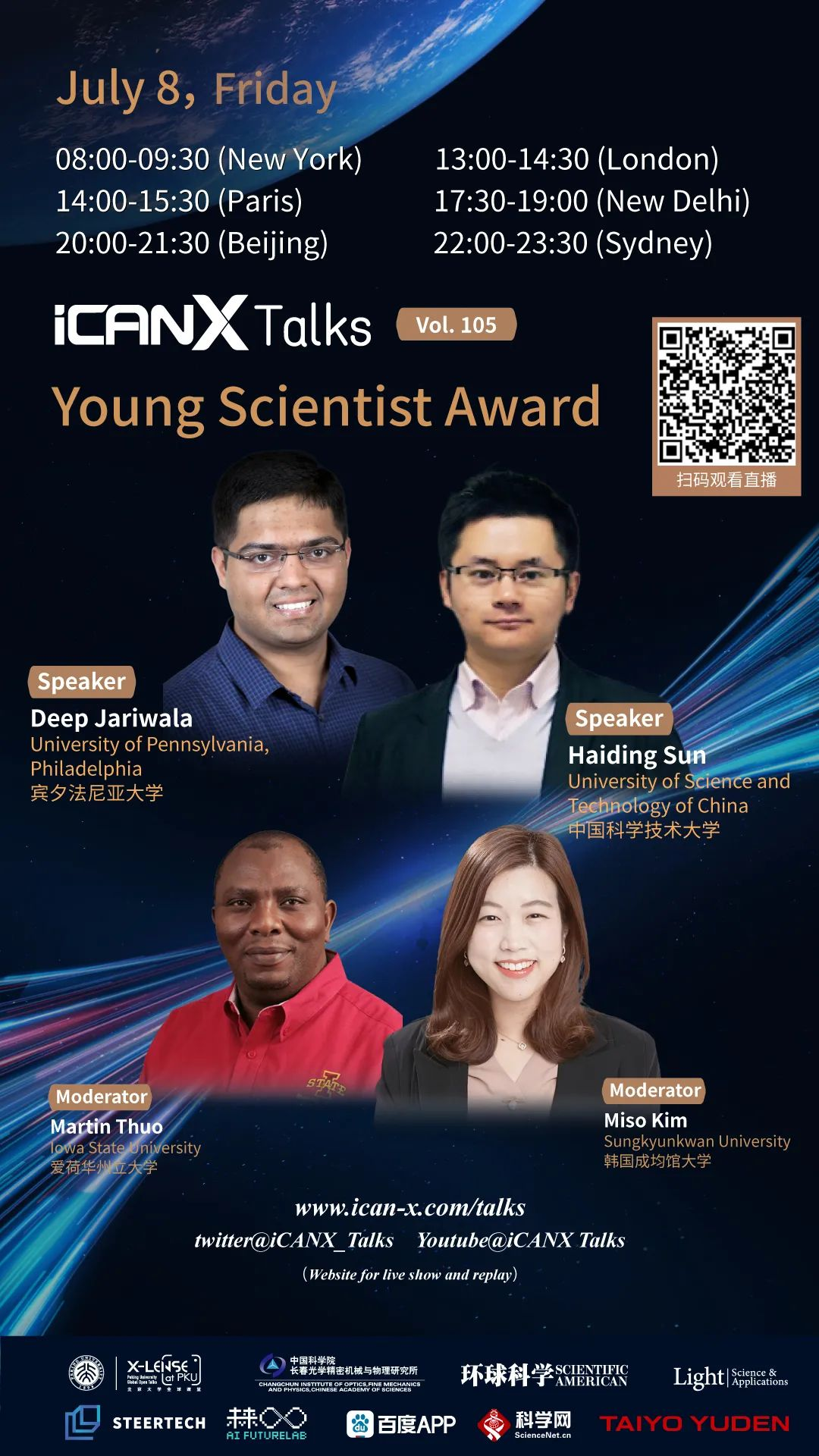Time: 20:00 pm, July 8, 2022, GMT+8
Venue: iCANX Talks platform
Long press to identify the QR code and jump to the webpage
Lecture 1
Title: Strong-Light Matter Interactions in Atomically-Thin Semiconductors
Speaker: Deep Jariwala, University of Pennsylvania, Philadelphia
Abstract:
The isolation of stable atomically thin two-dimensional (2D) materials on arbitrary substrates has led to a revolution in solid state physics and semiconductor device research over the past decade. These semiconductors are now considered building blocks for next generation of electronic, opto-electronic and photonic devices. In this talk, I will introduce the key concept of strong-light matter interactions in 2D semiconductors. In particular I will focus on the excitonic properties of these semiconductors and elaborate how the presence of intrinsic resonance enriches the physics of strong-interaction with light. I will present results on transition metal dichalcogenide semiconductors, their superlattices and perovskite semiconductors. If time permits I will also discuss strong interaction of light with magnetic semiconductors. Future prospects of these semiconductors will be discussed in conclusion.
Biography:
Deep Jariwala is an Assistant Professor in Department of Electrical and Systems Engineering at the University of Pennsylvania (Penn). His research interests broadly lie at the intersection of new materials, surface science and solid-state devices for computing, sensing, opto-electronics and energy harvesting applications. Deep completed his undergraduate degree in Metallurgical Engineering from the Indian Institute of Technology, Banaras Hindu University in 2010. Deep went on to pursue his Ph.D. in Materials Science and Engineering at Northwestern University graduating in 2015. At Northwestern, Deep made contributions to the study of charge transport and electronic applications of two-dimensional (2D) semiconductors and pioneering the study of gate-tunable, mixed-dimensional, van der Waals heterostructures. Deep then moved to Caltech as a Resnick Prize Postdoctoral Fellow from 2015-2017 working on nanophotonic devices and ultrathin solar cells before joining Penn in 2018 and starting his own group. Deep’s research has earned him awards of multiple professional societies including the Russell and Sigurd Varian Award and Paul H. Holloway Award of the American Vacuum Society, The Richard L. Greene Dissertation Award of the American Physical Society, Johannes and Julia Weertman Doctoral Fellowship, the Hilliard Award, the Army Research Office Young Investigator Award, Nanomaterials Young Investigator Award, TMS Frontiers in Materials Award, Intel Rising Star Award and IEEE Young Electrical Engineer of the Year Award in addition to being named in Forbes Magazine list of 30 scientists under 30 and is an invitee to Frontiers of Engineering conference of the National Academy of Engineering. He serves on the Editorial board of the journals Electronics and Micromachines and on the Early Career Editorial Advisory Board of Nano Letters. He has published over 90 journal papers with more than 13000 citations and 7 patents. At Penn he leads a research group comprising more than ten graduate and postdoctoral researchers supported by a variety of government agencies (NSF, DARPA, ARO, AFOSR), industries and private foundations.
Lecture 2
Title: Wide Bandgap Semiconductors for Ultraviolet Light Emitting and Detecting Devices
Speaker: Haiding Sun, the University of Science and Technology of China
Abstract:
The III-nitride family (AlN, GaN, InN, and their alloys) has been regarded as one of the most popular semiconductors in the past two decades for optoelectronics (light emitting diodes, photodetectors, etc.). Significantly, the InGaN-based light emitters have revolutionized the lighting industry, promoting energy-efficient and eco-friendly modern solid-state lighting and lasing technologies. Similarly, by alloying GaN with AlN, we can synthesize AlGaN ternary alloys with tunable direct bandgaps from 3.4 eV (GaN) to 6.1 eV (AlN), corresponding to a wide ultraviolet (UV) spectral range from 360 nm to 210 nm, for a broad range of applications including air/water purification, UV curing, data storage, optical communication, etc. In this presentation, we will focus on the development of AlGaN-based high performance UV LEDs and UV detectors. Particularly, we will discuss the successful demonstration of high-efficient deep-ultraviolet LEDs and high photoresponsive solar-blind photodetectors in the form of AlGaN-based nanowires.
Biography:
Prof. Haiding Sun received his Ph.D. in Electrical Engineering from Boston University. He is currently a professor in the School of Microelectronics at University of Science and Technology of China. He has published more than 90 peer-reviewed SCI-index journal papers including Nature Electronics, Advanced Functional Materials, Nano Letters, Optics Letter, IEEE Electron Device Letters, Applied Physics Letters etc. He has written 4 book chapters and holds 4 US, 4 PTC and 26 Chinese Patents. His research interests include the investigation of the physics, MBE and MOCVD epitaxy, fabrication, and characterization of wide bandgap semiconductor materials for both optoelectronics and electronic devices. This includes nanostructures and low-dimensional structures (quantum wires, dots, wells) for nanoelectronics and nanophotonics, based on group III-Nitrides and III-Oxides. His work has been highlighted by more than 100 times in many media outlets including Compound Semiconductors, Semiconductors Today, Phys.org, Nanowerk etc. He is an IEEE Senior Member.
Source: iCANX

